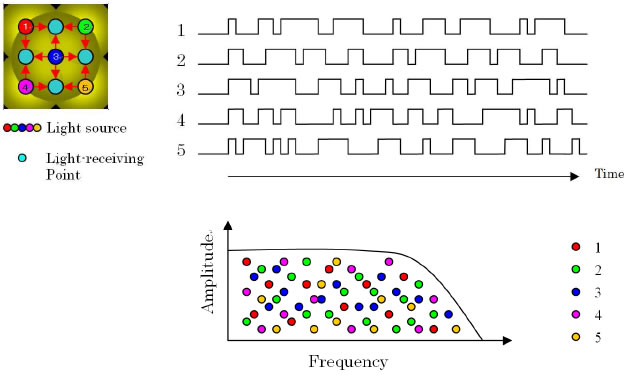2) Light modulation

When being tried to obtain the multipoint biological information at the same time, it can separate off where the light that reached a sensor came from. There, the light modulation technology is used. The equipment has adopted the spread spectrum multi-modulation method for the light modulation, that is one of the latest digital technologies.
So, NIRS (Near Infrared Reflectance Spectroscopy) including our equipment generally use the near-infrared ray in continuous wave (CW: Continuous wave) as a light source. TDMA (Time Division Multiple Access) or FDMA (Frequency Division Multiple Access) has been known as optical multi-modulation method in CW. This equipment has adopted CDMA (Code Division Multiple Access) that is quite different from the technique. CDMA is generally called spread spectrum modulation method from the principle. TDMA (Time Division Multiple Access) or FDMA (Frequency Division Multiple Access) has been known as optical multi-modulation method in CW. The equipment has adopted CDMA (Code Division Multiple Access) quite different from the conventional technique. CDMA is generally called spread spectrum modulation method from the principle.
TDMA is a method that controls each light source at the micro level, and a light source in a specific place emits a light at a certain moment. The sensor side where a light was received can separate off the light that came from a specific point by controlling the time. Though it is extremely advantageous in easy-to-use as a modulation method, it still has the disadvantages in easily influenced by turbulence light, and limitation to the biological signal bandwidth for multiple channels.
FDMA method light-modulates the light of each source at individual frequency to emit it. The sensor side where lights were received can separate off the lights that came from each point by separating them off with a frequency-dependent filter after changing the optical composite signal from each point into an electrical signal. It becomes less influenced by the turbulence light compared with TDMA, and is advantageous in its simultaneous measurement. Though it has the disadvantage in necessity of designing a precise frequency-dependent filter, complex circuit scale, and extreme difficulty for supporting multiple channels when exceeding a certain scale, it still is a light modulation technology with good prospects.
On the other hand, CDMA (Code Division Multiple Access), that is, the spread spectrum modulation is one of the most advanced modulation technologies, that is used for the recent mobile phones or GPS of car navigation systems. It is a modulation method that uses random numbers. Though it is rather difficult to understand the essential theory, it has the advantages in less influenced by turbulence light, simultaneous measurement, no big problem for multiple channels, and the actual circuit scale won’t be so large.
In the figure below, only the light source 1 lights up at the time 1, and the light is received at each receiving point It is the method to light up sequentially with time such as the light source 2 at the time 2, the light source 3 at the time 3, and so on in the same way.

In the figure below, the light sources 1~5 repeat lighting up at the same time at different modulation frequency. It is a method to specify the point and the optical signal strength at each receiving point by utilizing the different modulation frequency of a light signal from each light source even if each light source lights up at the same time.

Overview of CDMA (Spread spectrum modulation) method
In the figure below, the light sources 1~5 modulate with different random numbers, and repeat lighting up. The method is to specify the point and the optical signal strength at each receiving point by utilizing the difference in random number code of the optical signal from each light source even if each light source lights up at the same time.

Feature of each method (Use for light measurement)
| Light modulation method | TDMA Time Division Multiple Access |
FDMA Frequency Division Multiple Access |
CDMA Code Division Multiple Access |
|---|---|---|---|
| Principle | Simple | Complex | Difficult |
| Simultaneous measurement | Not good | Very Good | Very Good |
| Multi channels | Not good | Good | Very Good |
| High SN ratio | Limited bandwidth | Limited bandwidth | Available in various methods |
| Influence by disturbance noise | Large (Depending on modulation method) |
little | Very little |
| MODEM circuit | Simple/Small size | Complex/Large scale | Simple/Small scale |
| Practical application | Transmission packet of Internet | Terrestrial digital broadcasting (13-segment OFDM) |
Mobile phone ,
GPS Used for car navigation system |
| To top of page |
|---|

